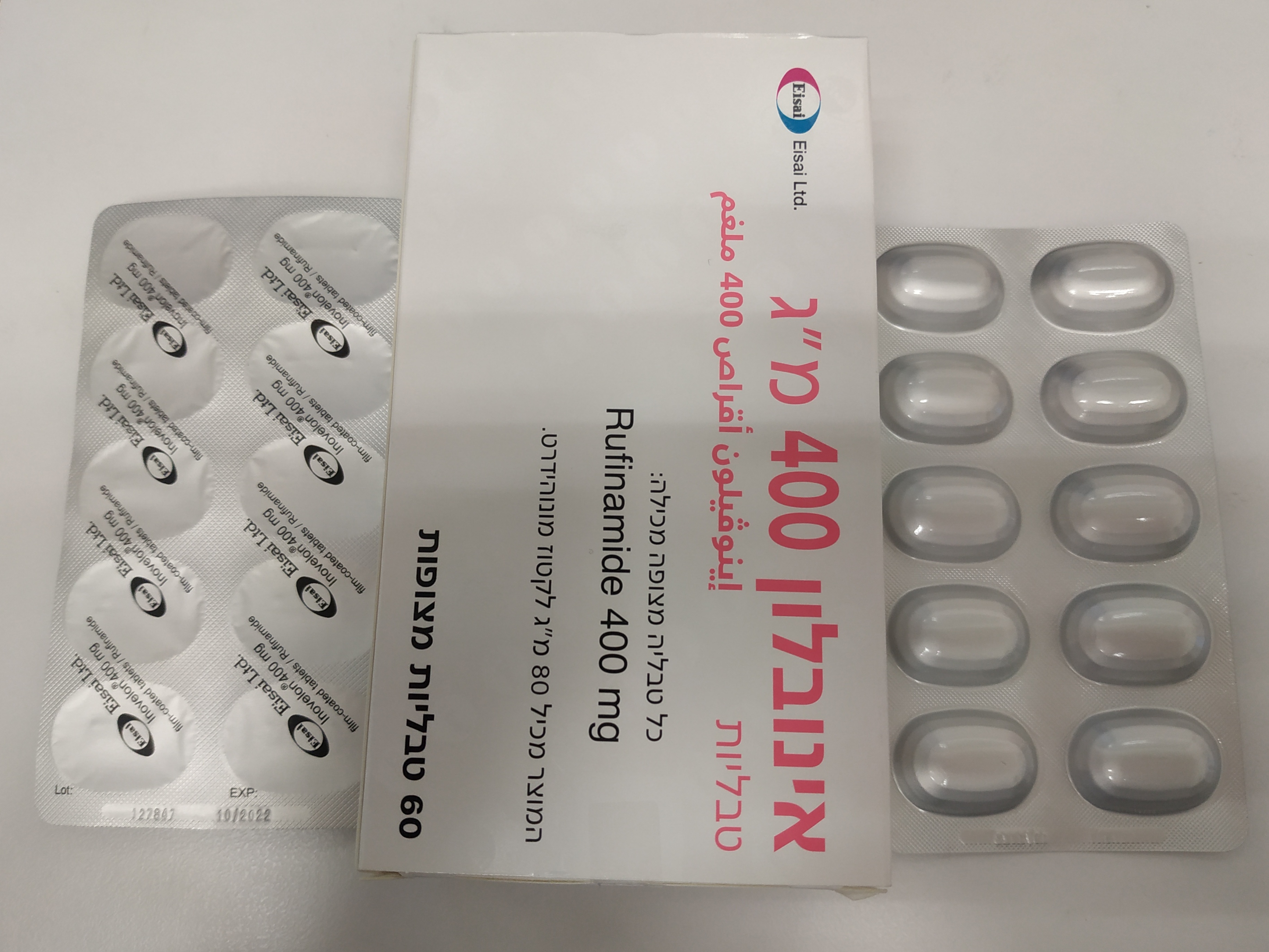Quest for the right Drug

אינובלון טבליות 400 מ"ג INOVELON 400 MG TABLETS (RUFINAMIDE)
תרופה במרשם
תרופה בסל
נרקוטיקה
ציטוטוקסיקה
צורת מתן:
פומי : PER OS
צורת מינון:
טבליות מצופות פילם : FILM COATED TABLETS
עלון לרופא
מינוניםPosology התוויות
Indications תופעות לוואי
Adverse reactions התוויות נגד
Contraindications אינטראקציות
Interactions מינון יתר
Overdose הריון/הנקה
Pregnancy & Lactation אוכלוסיות מיוחדות
Special populations תכונות פרמקולוגיות
Pharmacological properties מידע רוקחי
Pharmaceutical particulars אזהרת שימוש
Special Warning עלון לרופא
Physicians Leaflet
Adverse reactions : תופעות לוואי
4.8 Undesirable effects Summary of the safety profile The clinical development program has included over 1,900 patients, with different types of epilepsy, exposed to rufinamide. The most commonly reported adverse reactions overall were headache, dizziness, fatigue, and somnolence. The most common adverse reactions observed at a higher incidence than placebo in patients with Lennox-Gastaut syndrome were somnolence and vomiting. Adverse reactions were usually mild to moderate in severity. The discontinuation rate in Lennox-Gastaut syndrome due to adverse reactions was 8.2% for patients receiving Inovelon tablets and 0% for patients receiving placebo. The most common adverse reactions resulting in discontinuation from the Inovelon tablets treatment group were rash and vomiting. Tabulated list of adverse reactions Adverse reactions reported with an incidence greater than placebo, during the Lennox-Gastaut syndrome double-blind studies or in the overall rufinamide- exposed population, are listed in the table below by MedDRA preferred term, system organ class and by frequency. Frequencies are defined as: very common (≥ 1/10), common (≥ 1/100 to < 1/10), uncommon (≥ 1/1,000 to < 1/100), rare (≥ 1/10,000 to < 1/1,000). System Organ Class Very Common Common Uncommon Rare Infections and Pneumonia infestations Influenza Nasopharyngitis Ear infection Sinusitis Rhinitis Immune system Hypersensitivity* disorders Metabolism and Anorexia nutrition Eating disorder disorders Decreased appetite Psychiatric Anxiety disorders Insomnia Nervous system Somnolence* Status epilepticus* disorder Headache Convulsion Dizziness* Coordination Abnormal* Nystagmus Psychomotor hyperactivity Tremor Eye Disorders Diplopia Vision blurred Ear and Vertigo Labyrinth disorders Respiratory, Epistaxis thoracic and mediastinal disorders Gastrointestinal Nausea Abdominal pain upper disorders Vomiting Constipation Dyspepsia Diarrhoea Hepato-biliary Hepatic enzyme disorders increase Skin and Rash* subcutaneous tissue disorders Acne Musculoskeletal Back pain and connective tissue and bone disorders Reproductive Oligomenorrhoea system and breast disorders General Fatigue Gait disturbance* disorders and administration site conditions Investigations Weight decrease Injury, poisoning Head injury and procedural Contusion complications *Cross reference to section 4.4. Additional information on special populations Paediatric Population (age 1 to less than 4 years) In a multicentre, open-label study comparing the addition of rufinamide to any other AED of the investigator’s choice to the existing regimen of 1 to 3 AEDs in paediatric patients, 1 to less than 4 years of age with inadequately controlled LGS, 25 patients, of which 10 subjects were aged 1 to 2 years, were exposed to rufinamide as adjunctive therapy for 24 weeks at a dose of up to 45 mg/kg/day, in 2 divided doses. The most frequently reported TEAEs in the rufinamide treatment group (occurring in ≥10% of subjects) were upper respiratory tract infection and vomiting (28.0% each), pneumonia and somnolence (20.0% each), sinusitis, otitis media, diarrhoea, cough and pyrexia (16.0% each), and bronchitis, constipation, nasal congestion, rash, irritability and decreased appetite (12.0% each). The frequency, type and severity of these adverse reactions were similar to that in children 4 years of age and older, adolescents and adults. Age characterisation in patients less than 4 years was not identified in the limited safety database due to small number of patients in the study. Reporting of suspected adverse reactions Reporting suspected adverse reactions after authorisation of the medicinal product is important. It allows continued monitoring of the benefit/risk balance of the medicinal product. Any suspected adverse events should be reported to the Ministry of Health according to the National Regulation by using an online form https://sideeffects.health.gov.il.

פרטי מסגרת הכללה בסל
התרופה תינתן כטיפול משלים בתסמונת Lennox Gastaut.
מסגרת הכללה בסל
התוויות הכלולות במסגרת הסל
| התוויה | תאריך הכללה | תחום קליני | Class Effect | מצב מחלה |
|---|---|---|---|---|
| התרופה תינתן כטיפול משלים בתסמונת Lennox Gastaut. |
שימוש לפי פנקס קופ''ח כללית 1994
לא צוין
תאריך הכללה מקורי בסל
23/01/2011
הגבלות
תרופה מוגבלת לרישום ע'י רופא מומחה או הגבלה אחרת
מידע נוסף
